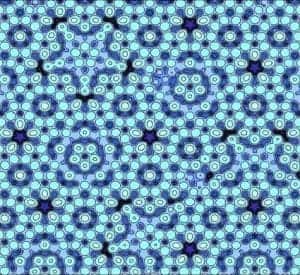What’s the difference between a solid and liquid? You might find this question trivial – naturally, liquids flow and solids… well, they don’t. From a physical point of view, however, things aren’t that simple. Intrigued by some ever so often encountered exceptions in the current accepted theory that describes the differences between the states of matter, scientists have tried to provide a new explanation. American researchers now argue that the main difference between liquids and solids is the way they respond to shear, or twisting forces and not the way atoms are arranged.

The water in the ocean, in liquid state, and a glacier, in solid state, are made out of the same H2O molecules. It’s how the atoms are arranged that governs what state of matter water will hold, or so classic textbooks have it. In liquids, atoms slosh around freely, while in solids the atoms are locked together in a crystal lattice. Because this crystal lattice is so stable, it needs a considerable amount of energy for the atoms to break rank.
This theory of rigidity fails to account for a number of exceptions – too many to remain unnoticed. For instance, it fails to account for quasicrystals — bizarre solids first discovered in the lab in 1982 and found in nature in 2009, which are arranged in patterns that never repeat, but the material is nonetheless rigid. Glass, one of the most familiar materials, is classed as amorphous – noncrystalline solid in which the atoms and molecules are not organized in a definite lattice pattern – and behaves like a solid, but if one looks closely enough it looks more like a liquid frozen in time.
“Glasses have been around for thousands of years,” said Daniel Stein, a professor of physics and mathematics at New York University. “Chemists understand them. Engineers understand them. From the point of view of physics, we don’t understand them. Why are they rigid?”
Even glaciers can’t be rigidly classified, since their atoms still flow, albeit very slowly. Even liquid water seems rigid if it collides with an object dropped from a large distance or if it’s crossed at high speeds. All these problems have prompted scientists to look for new ways to define the physical differences between liquids and solids, and a team of researchers from France and America believe they have pinpointed a more precise factor to mark the transition between the two states of matter – the way they respond to shear.
Response to shear delimits solids from liquids
Liquids pose minimal resistance to shear and can be twisted in any manner, while solids, even glass or quasi-crystals, pose resistance to shear in an attempt to maintain their shape. The liquid-solid phase transition should thus be marked, the researchers say, by the “shear response” of a material jumping from zero to a positive value.
Physicists typically make their phase boundary calculations for a material through an oversimplified model which assumes the material is boundless – otherwise, in their defense, things would take forever to complete. Unfortunately, this simplification ignores the shape of the material, making it difficult to determine whether the shape will change in response to shear.
Charles Radin, a mathematical physicist at the University of Texas at Austin, and his former student, David Aristoff, now a mathematician at the University of Minnesota built a 2-D model material in which atoms are represented by disks: At low densities corresponding to the material’s liquid phase, it showed no response to shear, but when the disks were densely packed, like the atoms in a solid, shear caused the material to expand. “The crossover where it shows this effect is exactly the density where the system becomes crystalline,” Radin said. “We propose this as a different way of understanding what a solid is.”
Meanwhile, in France, took an alternative route to describe the phase boundary and reasoned that the difference between solids and liquids is the rate at which they flow. Glass, though by all means a solid, still flows, very slowly that is. Even diamonds flow- their atoms that is, as some hop between defects or empty spots in the crystal lattice. To see a diamond flowing under the pull of Earth’s gravity, “one would have probably to wait more than the age of the universe,” said Giulio Biroli of the Institute of Theoretical Physics at CEA in Paris.
The researchers hypothesized that glass would fall somewhere in between a crystalline solid and a liquid by exhibiting a large but finite viscosity under small shear.
“Our ways are complementary,” said Biroli, of the American and French approaches. “If we take both of them, I think we start to understand the difference between a solid and a liquid.”





